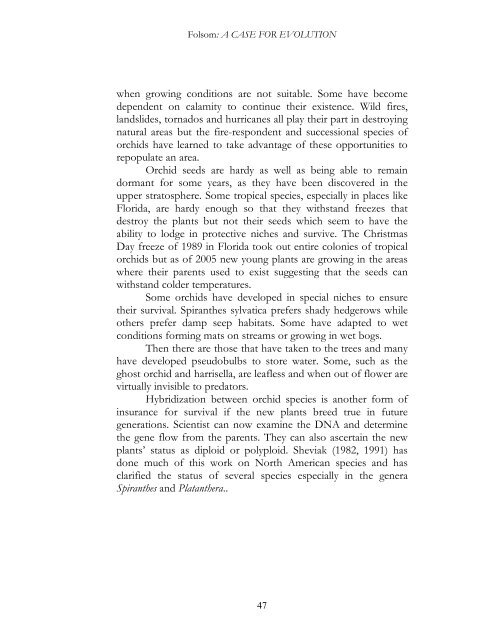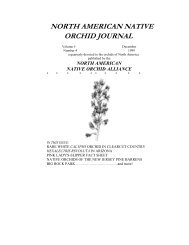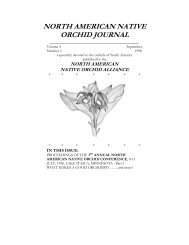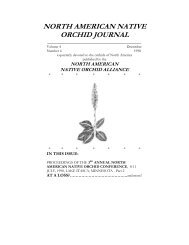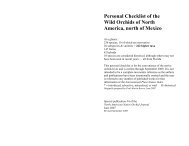north american native orchid journal - at The Culture Sheet
north american native orchid journal - at The Culture Sheet
north american native orchid journal - at The Culture Sheet
You also want an ePaper? Increase the reach of your titles
YUMPU automatically turns print PDFs into web optimized ePapers that Google loves.
Folsom: A CASE FOR EVOLUTION<br />
when growing conditions are not suitable. Some have become<br />
dependent on calamity to continue their existence. Wild fires,<br />
landslides, tornados and hurricanes all play their part in destroying<br />
n<strong>at</strong>ural areas but the fire-respondent and successional species of<br />
<strong>orchid</strong>s have learned to take advantage of these opportunities to<br />
repopul<strong>at</strong>e an area.<br />
Orchid seeds are hardy as well as being able to remain<br />
dormant for some years, as they have been discovered in the<br />
upper str<strong>at</strong>osphere. Some tropical species, especially in places like<br />
Florida, are hardy enough so th<strong>at</strong> they withstand freezes th<strong>at</strong><br />
destroy the plants but not their seeds which seem to have the<br />
ability to lodge in protective niches and survive. <strong>The</strong> Christmas<br />
Day freeze of 1989 in Florida took out entire colonies of tropical<br />
<strong>orchid</strong>s but as of 2005 new young plants are growing in the areas<br />
where their parents used to exist suggesting th<strong>at</strong> the seeds can<br />
withstand colder temper<strong>at</strong>ures.<br />
Some <strong>orchid</strong>s have developed in special niches to ensure<br />
their survival. Spiranthes sylv<strong>at</strong>ica prefers shady hedgerows while<br />
others prefer damp seep habit<strong>at</strong>s. Some have adapted to wet<br />
conditions forming m<strong>at</strong>s on streams or growing in wet bogs.<br />
<strong>The</strong>n there are those th<strong>at</strong> have taken to the trees and many<br />
have developed pseudobulbs to store w<strong>at</strong>er. Some, such as the<br />
ghost <strong>orchid</strong> and harrisella, are leafless and when out of flower are<br />
virtually invisible to pred<strong>at</strong>ors.<br />
Hybridiz<strong>at</strong>ion between <strong>orchid</strong> species is another form of<br />
insurance for survival if the new plants breed true in future<br />
gener<strong>at</strong>ions. Scientist can now examine the DNA and determine<br />
the gene flow from the parents. <strong>The</strong>y can also ascertain the new<br />
plants’ st<strong>at</strong>us as diploid or polyploid. Sheviak (1982, 1991) has<br />
done much of this work on North American species and has<br />
clarified the st<strong>at</strong>us of several species especially in the genera<br />
Spiranthes and Pl<strong>at</strong>anthera..<br />
47


